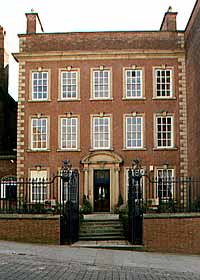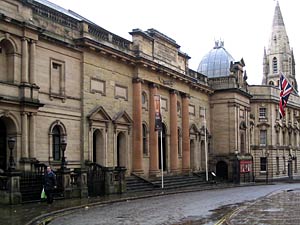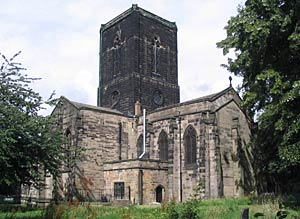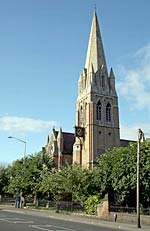< Previous | Contents | Next >
The quaint streets and old houses of Nottingham remain as a striking contrast in these days when Nottingham is putting on its 20th century dress. Hockley, leading into the heart of the town from the ancient village of Sneinton, has turned into a warehouse the 18th century chapel in which John Wesley preached his last Nottingham sermon, but it can never destroy the spot where William Booth used to stand and preach to passers-by who would stop and listen; it was the beginning of the Salvation Army. Friar Lane, leading from the Council House to the castle, has lost the little room in which William Carey preached the sermon which led to the founding of the Baptist Missionary Society, and has put the Theosophical Hall on its site; but across the road is the old Friends Meeting House, with a new outside dress, and opposite this, at the corner of Spaniel Row, is a tall gabled house where George Fox stayed with the sheriff when he was thrown into prison for interrupting the service at St Mary's. Henry Kirke White's birthplace in the old Shambles has been swallowed up by the Council House, but on a wall of the shopping arcade is a bronze plaque showing his father's little butcher's shop.

Willoughby House, Middle Pavement, in 2001.
In the short walk from Lister Gate following the line of part of the old town walls along the three Pavements towards St Mary's we come upon many notable 18th century buildings. On Low Pavement is Willoughby House, with a stone doorway and iron rails; it stands on some of the best rock cellars in the town. Just above is Vault Hall, used in the past for storing wool and as a secret meeting place of nonconformists; its arched gateway has perhaps the best old ironwork left in the town. The narrow thoroughfare at the corner of which it stands has been known as Drury Hill since Alderman Drury lived here in the 17th century. The four splendid fluted columns at Number Seven Low Pavement belong to the Old Assembly Rooms. Middle Pavement leads to Weekday Cross, where the Saxons held their market. Here was the town hall of the English borough in the time of the Normans; the Moot Hall Inn at the corner of Wheeler Gate and Friar Lane is on the site of the town hall of the French borough. On a wall in Weekday Cross a tablet marks the birthplace of Philip James Bailey, the Nottingham poet who wrote the forgotten poem of Festus, with the unforgettable lines:
We live in deeds, not years; in thoughts not breaths;
In feelings, not in figures on a dial.
We should count time by heart throbs: he most lives
Who thinks most, feels the noblest, acts the best.

Shire Hall in 2004.
On High Pavement is the Shire Hall, a stone building with pilastered entrance and balustraded parapet, where even till 1864 criminals were publicly hanged. Remains of the old prison can be seen at the back, and below are the cabins and dungeons used as condemned cells. The hall is unique among Nottingham buildings, for it is the smallest civil parish in all England, a bit of the county within the town, having been left under the old jurisdiction when Henry the Sixth separated the town from the county. Facing the Shire Hall is a fine house in which judges were lodged years ago, and in which the County Council now has offices. Much of it is still the old house where Lady Hutchinson lived while her famous stepson was governor of the castle; it is said that she was prosecuted for having music in this house on a Sunday. In the panelled hall, when we called, were two battered drums which beat the charge at the Battle of Culloden.
In Castle Gate, not far away, stands the square many-windowed Newdigate House of the time of Charles the Second, fronted by rich old ironwork. In it was sheltered the illustrious Marshal Tallard, who was captured at the Battle of Blenheim. He was a great gardener, and it is said that we owe to him the cultivation of celery, which he found growing wild in the neighbouring marshes. Facing Newdigate House is a house built by the master gunner of the Castle in the Civil War. Bromley House on Angel Row, facing the Council House, was built in 1725 by one of the banking Smiths. In Chapel Bar, a little way up the hill from the square, an early member of the Ingram family evolved the idea of the first illustrated paper. At the corner of Parliament Street and Newcastle Street, five minutes walk away, William and Mary Howitt had a chemist's shop, and in their parlour here Philip James Bailey read Festus to them, and a greater than all came to see them, William Wordsworth himself.
Not far off, at the bottom of Park Row, leading toward the General Hospital and the castle, are two traceried windows (over a shop) which attract the eye of the passer-by. They are perhaps the only windows that are left of the Houses of Parliament burned down at the beginning of the Victorian Era. Leading to the hospital yard from Postern Street is a beautiful archway of weathered timber, made from four spandrels of the 14th century roof of Alfreton church. In a cafe" in Wheeler Gate is a magnificent plaster ceiling moulded with fruit and flowers 300 years ago. The Walter Fountain in Carrington Street near here is a reminder that one of The Times proprietors was MP for Nottingham. In Bridlesmith Gate, one of the oldest streets in the heart of the town, are timber-framed shops with overhanging storeys, stone floors, and massive beams, and with caves behind them extending under neighbouring streets. Facing the castle from Castle Road is a group of modest 17th and 18th century dwellings with gabled roofs, and by them, partly hidden from the road, are the pleasant Jessamine cottages. But older than all these interesting things is the stone window built into the wall of an archway in the lace market. It is in Broadway, and as the window was made by Norman masons it is thought that it belonged to the Norman church which stood where St Mary's stands, close by.
One or two ancient inns remain in the city. The Trip to Jerusalem Inn is said to have been a calling-place for crusaders on their way to the Holy Land; it has rooms and cellars cut deep back into the castle rock, ventilating shafts climbing through the rock, a speaking tube bored through it, and a chimney climbing through the rock 47 feet above the chamber in which it begins. The Salutation Inn in Houndsgate, close by, has rock cellars which are believed to have been part of a Saxon cave settlement, and the inn itself has an overhanging gabled storey, with a painted sign of two clasped hands, representing Gabriel bringing the good news to Mary. It is nearly all 15th century. There are rock cellars in the Lion Hotel in Clumber Street, an old coaching inn; and another coaching inn, which has been delightfully restored, is the Flying Horse in the Poultry, its gabled front a pleasant vista from the arcade of the Council House. In the castle museum is an old chair in which the night porter of the Flying Horse used to sit.
In the ancient little graveyard called Fox's Close, at the meeting of St Ann's Well Road and Bath Street, lies a man whose name was once known far and wide. He was born William Thompson, he grew up to be the famous pugilist Bendigo, and he has been made familiar by Sir Conan Doyle as the Pride of Nottingham. His resting-place is typical of the old fighter, who was converted and became a popular preacher, and on occasion borrowed five minutes from the Lord that he might deal in his own way with the troublesome front row of the congregation:
But the roughs they kept on chaffin' and the uproar it was such
That the preacher in the pulpit might be talking double Dutch,
Till a working man he shouted out, a-jumpin' to his feet,
"Give us a lead, your reverence, and heave 'em in the street."
Then Bendy said, "Good Lord, since I first left my sinful ways,
Thou knowest that to Thee alone I've given up my days,
But now, dear Lord" (and here he laid his Bible on the shelf)
"I'll take with your permission just five minutes for myself."
On Bendy's tomb of rough grey stone crouches a fine lion as if about to spring, and the inscription runs:
In life always brave, fighting like a lion,
In death like a lamb, tranquil in Zion.
Nottingham has drawn within itself villages which the last generation knew as separate and distinct: Arnold, Basford, Beeston, Bestwood, Bilborough, Bulwell, Carlton, Colwick, Daybrook, Lenton, and Wollaton. Most of them are completely in the city, and some partly, and some of them have enough village character left to belong to the countryside still. Others are as much a part of the city's life as the crowded district of Sneinton, where William Booth and Jesse Boot began their work.

St Stephen's church, Sneinton, in 2007.
Sneinton is within easy reach of the City Centre, near the bottom of Hockley, and it has two modern churches worth coming to see. St Stephen's is spacious and pleasing, with a central tower and lofty arches, a barrel roof to the nave, and good oak screens. The reredos in the chancel has canopied scenes in the Life of Our Lord. The oak reredos in the south transept chapel has canopied statues of the Madonna, Isaiah, and John the Baptist. The treasure here lies in the medieval seats in the chancel, which were cast out of St Mary's last century; the panelling on the walls has a cresting of shields and Tudor flower, and spandrels carved with two snarling dragons, grotesque heads with foliage coming from their mouths, a mermaid with her comb and mirror, and a quaint animal. In the rich carvings of eight of the miserere seats are heads, an animal with another animal on its back, a quaint creature,like an ass, a chained monkey holding a pitcher, and an animal blowing a horn as it rides on a hound. The poppyheads have foliage and faces, human and grotesque. Tucked away in drab surroundings, a stone's throw from the turmoil of Sneinton market, is St Alban's Church of 1887. Inconspicuous outside with its brick walls and modest turret for one bell, its fine stone interior is all the more surprising and arresting in its spaciousness and stately height. It has fine arcades, pleasing glass, and a lofty oak screen.
In St Stephen's churchyard, east of the chancel, lies a little-known mathematical genius who inspired Lord Kelvin. He was George Green. On the flat stone marking his grave (with inscriptions to his parents and his son as well as his own) we found a wreath from the British Association, which had lately organised a pilgrimage to his grave and his old home. He was born at Sneinton Mill, a landmark at the top of a steep climb not far from his resting-place, its old red brick cone wearing a copper domed cap, its sails gone. On it a tablet tells of this man, who would climb to the top storey of the mill (when he could spare time from helping his father to grind corn) to study the scientific problems on which he was to throw so much light. He would see the wonderful panorama which rewards all who climb this hill.
The busy suburb of Basford has its old church dedicated to the little-known St Leodigarius, and the church has still Norman masonry in its walls, 13th century work in the chancel, the nave arcades, the font and the south doorway, and 15th century work in the south aisle and the south porch. The porch has a gallery of medieval heads. The west window with the Good Shepherd and the Light of the World is in memory of Henry Roger Pitman, who was vicar here for the whole of the second half of last century and two years of this. Built into the wall by the south doorway is an ancient Pax stone, which had some significance long ago in connection with the Apostolic injunction, "To greet one another with a holy kiss." Near the porch is the stone tomb of Henry Ward who is said to have died at 108, and close by the church is an old brick manor house in which Philip James Bailey lived.
Bulwell lost its old church when the new one was built last century, but it keeps its old 17th century grammar school founded by George Strelley, who wished that the pupils might be "used mildly and taught Latin and accounts." It is no longer a school, but has been taken over by the Association for Unemployed Workers as a recreation centre. Its diapered brick walls are among the oldest in this part of Nottingham and the building has curved gables and a two-storeyed porch.

Daybrook church in 2008.
© Copyright Alan Murray-Rust and licensed for reuse under this Creative Commons Licence
Daybrook, on the fringe of the city, has built two fine things for all to see who pass along this busy stretch of the old North Road. Side by side, both of our own day, they are tributes in stone to the love of a man for his wife and the love of a father for his son.
One is the splendid block of almshouses with lawns and flowers and a fine gateway, given in memory of his son by Sir John Robinson. The other is the church, whose beauty has only to gain with the mellowing of time. Its great tower, with fine windows, pinnacles, and a lofty spire, stands at a corner and forms a south porch with a vaulted roof. The great west window is between buttresses adorned with figures in canopied niches, and above it is an array of eight more handsome niches.
Attractive as it is outside the church is equally so within, where arcades of four bays divide the nave and aisles. It is so spacious and lofty that 15 windows glowing with countless figures do not rob it of light. The great east window of seven lights has nearly 70 figures; and shining in the west are the twelve Disciples. The only plain glass is in the clerestory. A charming feature of the church is the stone, which seems to burst into life in a wonderful mass of carving— in the alabaster reredos with its vivid scene of the Last Supper, in the three sedilia and the piscina, in the pulpit with figures all round, and in the font, which has on its seven sides figures of Faith, Hope, Charity, Courage, Truth, Purity, and Industry.
Delicately beautiful is the ironwork on each side of the chancel, and on the gated chancel screen. The floor of the chancel is Italian mosaic in soft colours of cream and green and rose; but loveliest of all is Sir Thomas Brock's marble figure of a beautiful woman in the sanctuary, a gentle smile on her lips, and a lily beneath her folded hands. Her head is on an embroidered cushion, and a light wrap draped over her hair is knotted on her breast. We read that she was gentle and good, the friend and counsellor and delight of all who knew her. It is fitting that we should find her here, for she inspired the beauty all about her. She was the wife of Colonel Charles Seely and mother of Lord Mottistone; and the church, built by Mr J. L. Pearson RA, architect of Truro Cathedral, is her memorial. Colonel Seely was MP for Nottingham and gave £100,000 to its hospital.
The bringing of part of Bestwood Park into the city added to Nottingham more than a thousand acres, though the heart of the city is six miles from the Park. Charles the Second gave this estate to Nell Gwynn's son Charles Beauclerk, whom he made the first Duke of St Albans when Nell Gwynn threatened to throw the brat out of the window. The tenth duke built Bestwood Lodge last century, making it a handsome brick house with gables, and he also built the church in which he lies.
The Queen of the Midlands, by bringing more than 5000 acres into her area in 1932, increased her kingdom to 16,166 acres. She is the 12th great town in the provinces, and is making herself in every sense worthy of her central place in the industrial, commercial, and intellectual life of the nation.
